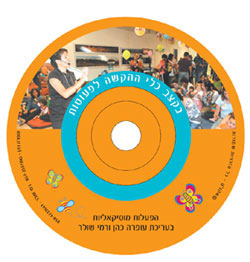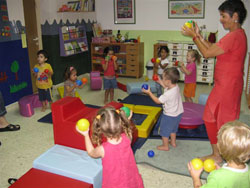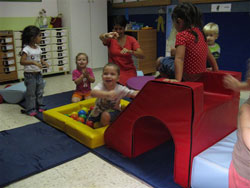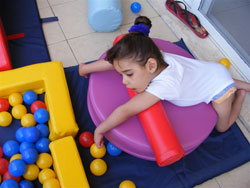Develop and enjoy
![]()
Develop and enjoy
It is important that quality time of the parent and baby in the first year include also physical activity that encourages the motor development, coordination and equilibrium. So you will help the little ones to move.
By: Dana Alperon, psychologist, Developmental and educational consultant to the GYMBOX.
Consultation and exercises: Orna Elad, feldenkreis teacher and and developmental accompaniment to the preschoolers.
Experimentation in a variety of motor activities contributes to the development of the baby, Reinforces his confidence and his Social and emotional skills and provides hours of quality time of parent and baby an additional value of promoting the developmental capabilities while playing and having fun. Various areas of development are interrelated.
Motor development begins in the development of the control of the rough muscles: Neck muscles, shoulders, arms and legs, and moves to control the fine muscles, such as the finger muscles. Through the motion and the experimentation with various senses the infant develops also the thinking, language and the concepts of the child.
Nursery equipment market offers quite a few accessories and babies activity surfaces, the following exercises are designed to perform on the GYMBOX – motor activity centre for the domestic environment. This modular cube unfolds to six edges and becomes a sport mattress that combines various elements, such as balls pools, cylinders of different sizes, swings, stairs, slope to the climbing and sliding, crawling tunnel and balance surface.
Motor activities include crawling through narrow passages, decline and climbing on steps of large building cubes, climbing and sliding the slide, maintaining the balance, ball games : throwing, catching, rolling , etc. The more the babies experience more so they will improve their abilities to more qualitative complex and coordinated movements. In addition to the development and to the improvement of gross motor skills, the babies will achieve other important skills such as visual and spatial perception, fine motor skills, and eye – hand coordination and development of body image and thinking. Every baby has a different development rate. The proposed exercises suitable for babies aged three months to a year and a half. Be sure to adjust the exercises to the developmental stage of the baby. It is recommended to allow the baby a motorial room and to encourage it to experiment with a variety of positions and exercises, all this while helping to maintain his safety and paying attention to the cooperation and to the enjoyment he feels during the exercise.
Development of balancing skills and crawling encouragement
Accompanying object: a swing which is composed of two
half-circles and half a cylinder
Exercise position: Lay the baby on his belly on the half
cylinder while supporting him in the hip and legs area.
The exercise: Swing him gently and encourage him to crawl
over the whole length of the half-cylinder.
Developmental contribution: Lying on the belly in a
number of positions encourages motorial development. The
head lifting helps to strengthen the neck and shoulder-belt
muscles.
The maintenance of balance while crawling on an unstable
surface (such as a swing) assists in the development of a
healthy muscle tonus.


The development of balancing skills while passing through a narrow space
Accompanying object: a wheel which is composed of two
half-circles
Exercise position: The wheel is laid on the mattress. Lay
the baby behind the wheel, hold the wheel, and position
some balls in front of him.
The exercise: Peek occasionally and encourage the baby
to pass through the wheel while playing with the balls, turn
the wheel gently.
Developmental contribution: The development of balancing
and movement stability skills through a narrow passage
contributes to the development of body-control senses and
spatial orientation.


The development of balancing skills
Accompanying objects: a wheel which is composed of two
half-circles
Exercise position: Lay the wheel on the mattress
and then lay the baby on the wheel, support him at the hip with
one hand and under the chest with the other hand.
The exercise: Move the wheel backwards and forwards.
Developmental contribution: Exercises which include
lying on the belly are important for the development of
front-body senses (underbelly, belly and chest), they also
help to strengthen the neck and shoulder-belt muscles.
Balance shifting movements are significant for the
development of crawling


Development of balancing and movement skills
Accompanying objects: steps and a slide a slope for
climbing and crawling
Exercise position: (when the baby can sit on its own) lean
or position the baby on his knees with his chest and arms
leaning on the steps (afterwards the leaning will be on the
slope).
The exercise: Support the baby at the hips and legs and
encourage him to climb the steps in the direction of the
slide.
Developmental contribution: Encourages the lifting and
lowering of the hips. It is important as a preparation before
crawling, sitting, standing and walking.


Development of balancing and movement skills
Accompanying objects: steps and a slide (a slope for
climbing and crawling), and a ball pool.
Exercise position: Wheelbarrow position.
The exercise: Help the baby to disconnect both hands
one after another, and then help him to gently move
forward down the slope in the direction of the ball pool.
At a later stage the baby will slide on his belly with the
head and arms in the leading directrion.
Developmental contribution: For babies who already
crawl and sit, the slide constitutes a challenging and
cheering background for development.
They improve their movement through climbing and
sliding in both directions of gravity.


Encouragement of crawling and the development of movement skills
Accompanying object: A ball pool and cylinders
Exercise position: Lay/seat the baby in the ball pool, put
all the different sizes of cylinders and half-cylinders in front
of him.
The exercise: Sit next to the baby for support and
encourage him to exit the ball pool while positioning a ball
on one of the cylinders (which is in front).
Developmental contribution: The edge of the ball pool is
challenging and it demands greater movement skills from
the baby in order to cross it. Through the climbing and
descending (coming down) the baby learns to coordinate
the arms and feet and improve his movement. The game
with the balls helps in developing light motorial skills and
hand-eye contact.
























